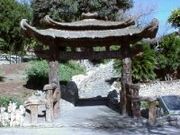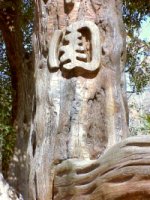
Faux Bois
Encyclopedia


Renaissance
The Renaissance was a cultural movement that spanned roughly the 14th to the 17th century, beginning in Italy in the Late Middle Ages and later spreading to the rest of Europe. The term is also used more loosely to refer to the historical era, but since the changes of the Renaissance were not...
with trompe-l'œil. It was probably first crafted with concrete using a steel armature
Armature
Armature may refer to:* Armature , the kinematic chains used in computer animation to simulate the motions of virtual characters...
by the inventor of ferrocement
Ferrocement
The term ferrocement is most commonly applied to a mixture of Portland cement and sand reinforced with layers of woven or expanded steel mesh and closely spaced small-diameter steel rods rebar. It can be used to form relatively thin, compound curved sheets to make hulls for boats, shell roofs,...
, Joseph Monier
Joseph Monier
-Overview:Joseph Monier was a French gardener and one of the principal inventors of reinforced concrete....
. In 1875, Monier created the first bridge of reinforced concrete
Reinforced concrete
Reinforced concrete is concrete in which reinforcement bars , reinforcement grids, plates or fibers have been incorporated to strengthen the concrete in tension. It was invented by French gardener Joseph Monier in 1849 and patented in 1867. The term Ferro Concrete refers only to concrete that is...
at Chazelet, France. It was sculpted to resemble timbers and logs.
Ferrocement faux bois uses a combination of concrete, mortar
Mortar (masonry)
Mortar is a workable paste used to bind construction blocks together and fill the gaps between them. The blocks may be stone, brick, cinder blocks, etc. Mortar becomes hard when it sets, resulting in a rigid aggregate structure. Modern mortars are typically made from a mixture of sand, a binder...
and grout
Grout
Grout is a construction material used to embed rebars in masonry walls, connect sections of pre-cast concrete, fill voids, and seal joints . Grout is generally composed of a mixture of water, cement, sand, often color tint, and sometimes fine gravel...
applied to a steel frame or armature to sculpt life-like representations of wooden objects. Final sculpting can be done while the mixture is wet, in a putty state, or slightly stiff. Techniques vary among artisans. Most popular in the late 19th century through the 1940s, ferrocement faux bois has largely disappeared with the passing of those most expert in its practice. What few objects remain from that peak period (mostly in the form of garden art, such as planters and birdbaths) are now highly prized by collectors.
In Mexico, this style was known as "El Trabajo Rústico" (The Rustic Work). One highly regarded artist who worked in this style was Dionicio Rodriguez
Dionicio Rodriguez
Dionicio Rodriguez was a Mexican-born artist and architect whose work can be seen in Alabama, Arkansas, Illinois, Maryland, Michigan, New Mexico, Tennessee, and Texas, as well as Washington, D.C. and Mexico City....
, a Mexican who relocated to Texas in the early 1920s. Although not widely known, his large-scale faux bois installations have been listed on the National Register of Historic Places
National Register of Historic Places
The National Register of Historic Places is the United States government's official list of districts, sites, buildings, structures, and objects deemed worthy of preservation...
. Dionicio's great-nephew is one of the handful of artists still creating Faux Bois today.
See also
- Dionicio RodriguezDionicio RodriguezDionicio Rodriguez was a Mexican-born artist and architect whose work can be seen in Alabama, Arkansas, Illinois, Maryland, Michigan, New Mexico, Tennessee, and Texas, as well as Washington, D.C. and Mexico City....
- Faux paintingFaux paintingFaux painting or faux finishing are terms used to describe a wide range of decorative painting techniques. The naming comes from the French word faux, meaning false, as these techniques started as a form of replicating materials such as marble and wood with paint, but has subsequently come to...
- GrainingGrainingGraining is the practice of imitating woodgrain on a non-wood surface in order to increase that surface's aesthetic appeal. Graining was common in the 19th century, as people were keen on imitating hard, expensive woods by applying a superficial layer of paint onto soft, inexpensive woods. Graining...
- Trompe-l'œil
- Joseph MonierJoseph Monier-Overview:Joseph Monier was a French gardener and one of the principal inventors of reinforced concrete....
- FerrocementFerrocementThe term ferrocement is most commonly applied to a mixture of Portland cement and sand reinforced with layers of woven or expanded steel mesh and closely spaced small-diameter steel rods rebar. It can be used to form relatively thin, compound curved sheets to make hulls for boats, shell roofs,...
- Reinforced concreteReinforced concreteReinforced concrete is concrete in which reinforcement bars , reinforcement grids, plates or fibers have been incorporated to strengthen the concrete in tension. It was invented by French gardener Joseph Monier in 1849 and patented in 1867. The term Ferro Concrete refers only to concrete that is...

